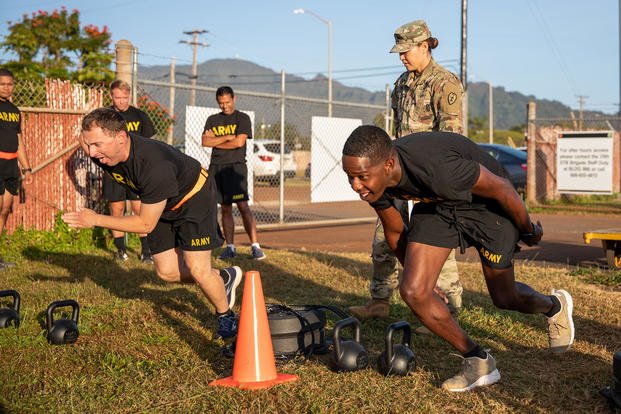The most common fitness testing issues for new military recruits are running, push-ups, pull-ups, sit-ups, swimming and now lifting weights. Though you may have experience in some of these events, most people (athletes included) are not good at all of these activities, especially when tasked to perform them back to back with maximum effort.
Depending on your branch of service and the job you seek within the military, you may have to be good at all of the above and overcome any potential issues.
Here are some common fitness testing issues and how to overcome them.
Running
If you're not used to running long distances, the military fitness test can be daunting. You can train and gradually increase your endurance so that you can complete the test with ease, but this will take time. Test distances in the military range from 1.5 miles in the Navy, Coast Guard and Air Force; two miles in the Army; three miles in the Marine Corps; four miles at SEAL training; and five miles at Army Ranger School.
Depending on your choices, your preparation time may take longer than you expect if you want to perform well and be competitive.
Don't forget rucking and agility shuttle runs. Both of those can be challenges to different types of athletes as well. Running is not just for endurance. Speed, agility, power and load-bearing durability are now tested in many military training schools. Running and rucking at longer distances will also be a requirement once you get into your basic or special ops selection training.
Push-ups
Push-ups may be the most common challenge that people have with the military fitness test. A good way to overcome these issues is to practice three days a week for months prior to joining the military. You will gradually increase the number of push-ups you can do if you do them consistently every other day.
Pull-ups
Another common issue people have with the military fitness test is not being able to do pull-ups. Pull-ups are the great equalizer and considered the "heavy lifting" of calisthenics exercises. You have to first build the strength to lift your body over a bar, then increase your muscle stamina to do multiple pull-ups (10-20+).
Get Better at Pull-ups. Get Your FIRST Pull-up.
Sit-ups
Most people fail to understand that sit-ups are typically a pacing exercise. Many will start off too fast and burn out in 30 seconds, However, if they pace themselves from the start, they will last longer and do more sit-ups. The key is to master your pace, just like with running.
Swimming
The swimming portion of the military fitness test can be difficult for people who are not used to swimming fast for several laps (typically 500 yards or 500 meters). If you want to improve at all, swimming requires significant technique training and practice. Next, swimming requires conditioning to get into swimming shape.
Both efficiency and conditioning (getting into swimming shape) matter if you want to develop above-average swimming ability. Swimming is a basic survival skill, so not being able to swim when you join the military is potentially dangerous. If you're not able to swim or tread water, that renders you ineffective on 75% of the globe. Take lessons if you must. Yes, it is that important.
Get Better at Swimming and next-level Diving Skills.
Lifting Weights
The lifting portion of the military fitness test can be difficult for people who are not used to weights. However, you can train and gradually increase your strength so that you can complete the test with ease. There are a few load-bearing activities that are tested by the military on the Army Combat Fitness Test, the USMC Combat Fitness Test and other Tactical Fitness Tests within the Special Ops Communities.
Get Better at Lifting Weights for Fitness Tests.
But learn how to train and consider a smart split routine when lifting.
The big takeaway is that there are many things that recruits need help with when it comes to fitness testing. Getting good at all the elements of fitness is what a "tactical athlete" needs to do. Depending on the branch of service, job, athletic history and current fitness level, the specific method of improvement will vary greatly.
Make sure you understand the specific requirements for your chosen path and adjust your pre-military training to not only master the fitness test to enter your preferred program but also to allow for you to get through that program and graduate with your choice of military service professions. Your success truly depends on how you train before joining the military.
-- Stew Smith is a former Navy SEAL and fitness author certified as a Strength and Conditioning Specialist (CSCS) with the National Strength and Conditioning Association. Visit his Fitness eBook store if you're looking to start a workout program to create a healthy lifestyle. Send your fitness questions to stew@stewsmith.com.
Want to Learn More About Military Life?
Whether you're thinking of joining the military, looking for fitness and basic training tips, or keeping up with military life and benefits, Military.com has you covered. Subscribe to Military.com to have military news, updates and resources delivered directly to your inbox.


















